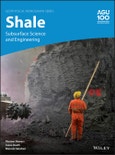Advances in theories, methods and applications for shale resource use
Shale is the dominant rock in the sedimentary record. It is also the subject of increased interest because of the growing contribution of shale oil and gas to energy supplies, as well as the potential use of shale formations for carbon dioxide sequestration and nuclear waste storage.
Shale: Subsurface Science and Engineering brings together geoscience and engineering to present the latest models, methods and applications for understanding and exploiting shale formations.
Volume highlights include:
- Review of current knowledge on shale geology
- Latest shale engineering methods such as horizontal drilling
- Reservoir management practices for optimized oil and gas field development
- Examples of economically and environmentally viable methods of hydrocarbon extraction from shale
- Discussion of issues relating to hydraulic fracking, carbon sequestration, and nuclear waste storage
Book Review: I. D. Sasowsky, University of Akron, Ohio, September 2020 issue of CHOICE, CHOICE connect, A publication of the Association of College and Research Libraries, A division of the American Library Association, Connecticut, USA
Shale has a long history of use as construction fill and a ceramic precursor. In recent years, its potential as a petroleum reservoir has generated renewed interest and intense scientific investigation. Such work has been significantly aided by the development of instrumentation capable of examining and imaging these very fine-grained materials. This timely multliauthor volume brings together 15 studies covering many facets of the related science. The book is presented in two sections: an overview and a second section emphasizing unconventional oil and gas. Topics covered include shale chemistry, metals content, rock mechanics, borehole stability, modeling, and fluid flow, to name only a few. The introductory chapter (24 pages) is useful and extensively referenced. The lead chapter to the second half of the book, "Characterization of Unconventional Resource Shales," provides a notably detailed analysis supporting a comprehensive production workflow. The book is richly illustrated in full color, featuring high-quality images, graphs, and charts. The extensive index provides depth of access to the volume. This work will be of special interest to a diverse group of investigators moving forward with understanding this fascinating group of rocks.
Summing Up: Recommended. Upper-division undergraduates through faculty and professionals.Table of Contents
Contributors vii
Preface ix
Acknowledgments xi
Part I: Shale and Clay Overview
1. Mudrock Components and the Genesis of Bulk Rock Properties: Review of Current Advances and Challenges 3
Kitty L. Milliken and Nicholas W. Hayman
2. Chemical Composition of Formation Water in Shale and Tight Reservoirs: A Basin‐Scale Perspective 27
Yousif Kharaka, Kathleen Gans, Elisabeth Rowan, James Thordsen, Christopher Conaway, Madalyn Blondes, and Mark Engle
3. From Nanofluidics to Basin‐Scale Flow in Shale: Tracer Investigations 45
Yifeng Wang
4. Metals in Oil and Gas‐Bearing Shales: Are They Potential (Future) Ore Deposits? 59
Mark J. Rigali and James L. Krumhansl
5. Coupled Thermal-Hydraulic-Mechanical and Chemical Modeling of Clayed Rocks 69
Leonardo do N. Guimarães, Antonio Gens, and Marcelo Sánchez
6. Thermo‐Hydro‐Mechanical Testing of Shales 83
Alessio Ferrari and Enrique Romero Morales
7. Geomechanics of Shale Repositories: Mechanical Behavior and Modeling 99
Miguel A. Mánica, Daniel F. Ruiz, Jean Vaunat, and Antonio Gens
8. Generation and Self‐Sealing of the Excavation‐Damaged Zone (EDZ) Around a Subsurface Excavation in a Claystone 125
Paul Bossart, Christophe Nussbaum, and Kristof Schuster
9. Shale and Wellbore Integrity 145
J. William Carey and Malin Torsæter
Part II: Unconventional Oil and Gas
10. Characterization of Unconventional Resource Shales (Mudstones): The Necessity of Multiscale Scientific Integration 163
Roger M. Slatt
11. Wellbore Mechanics and Stability in Shale 197
Amin Mehrabian, Vinh X. Nguyen, and Younane N. Abousleiman
12. Modeling Hydraulic Fracturing of Unconventional Reservoirs 213
Ahmad Ghassemi and Zhennan Zhang
13. Flow of Gas and Liquid in Natural Media Containing Nanoporous Regions 235
Timothy J. Kneafsey and Sharon Borglin
14. Factors Affecting Hydrocarbon and Water Mobility in Shales 255
Charles Bryan and Pat Brady
15. Dynamics of Matrix‐Fracture Coupling During Shale Gas Production 273
I. Yucel Akkutlu and Asana Wasaki
Index 287








